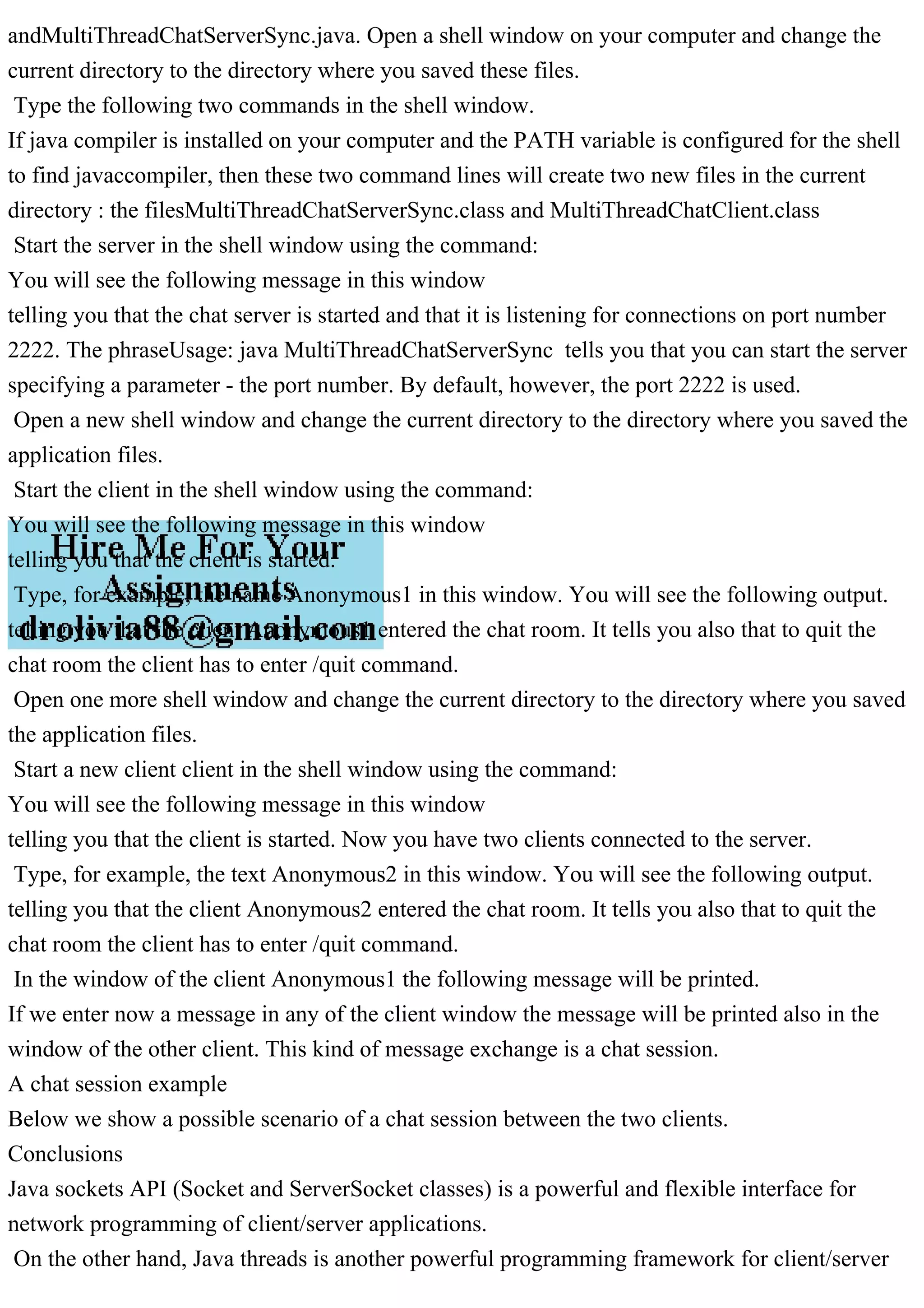The document explains how to create network connections in Java using sockets, detailing both TCP (connection-oriented) and UDP (connectionless) protocols. It covers how to implement client/server applications and manage socket communication, including opening sockets, sending/receiving data, and closing connections, while also addressing synchronization issues for multi-threaded applications. The document further provides examples of client and server implementations, along with steps for compiling and running these applications.




![The synchronization issues of the multi-threaded chat server implementation Consider now the synchronization issues such an implementation creates. To simplify our task let us split the chat server code as follows, see the partitioned code below. Consider the portions of code colored in green, that is, the portions 2,4,6,8,10 (see the code above). All these portions use the array threads[]. This array, however, is shared by all threads of the server. The array is passed by reference to the constructor of the thread every time a new thread is created. The modification of this array by a thread is visible by all other threads. These portions of code are called critical sections because, if used uncontrolled, they can cause unexpected behaviour end even exceptions as explained below. Since all threads run concurrently, the access to this array is also concurrent. Suppose now that a thread (Thread 1) enters the portion 4 while another thread (Thread 2) enters the section 10 of the code. The section 4 uses the array threads[] to inform the clients about a new client. The section 10, however, removes from this array the thread references of the client that leaves the chat room. It can happen, that a threads[i] reference, while being used in section 4, is set to null in section 10 by another thread - by the thread of the client leaving the chat room. The table below shows this scenario. In this scenario the Thread 1 executes the if statement in portion 4. Suppose threads[i] is not null at this instant. Suppose, also, Thread 1 is interrupted by the operating system immediately after evaluating the if statement condition. It means, Thread 1 is put in a waiting queue, while the Thread 2 starts executing portion 10. Such kind of execution is called inter-living. Suppose, Thread 2 sets threads[i] to null when executing portion 10. Finally, Thread 1 is resumed and executesthreads[i].os.println() statement. But threads[i] is null at this instant. This will cause a null pointer exception. This exception will close abnormally the connection with a client. And all that because of another client that decided to leave the chat room. The same situation can arise if we consider the concurrency of any of the section 2,6,8 with the section 10. Such situations are not acceptable and must be resolved correctly in a concurrent multi-threaded application. To avoid such kind of exception, the threads must be synchronized so that they execute the critical portions of code (in green) sequentially, and thus, without inter-living. For example, in the table below, the execution of the two portions of code is sequential - the critical sections executes without interruption. We call such execution synchronized. To archive this synchronization we have to use the synchronized(this){} statement, like below. All synchronized(this){} statements exclude mutually each other. It means, that when a thread enters thesynchronized(this){} statement it verifies first that any other synchronized(this){} statement is not being executed by another thread. If a such a statement is being executed by a thread, then this thread, as well as all other threads trying to execute a synchronized(this){} statement, are forced to wait until the thread executing the synchronized(this){} terminates this](https://image.slidesharecdn.com/howanetworkconnectioniscreatedanetworkconnectionisiniti-230630175449-2f6a28bf/75/How-a-network-connection-is-created-A-network-connection-is-initi-pdf-5-2048.jpg)
![statement. When the thread executing a synchronized(this){}statement leaves the critical section, that is, when it terminates the synchronized(this){} statement, a thread waiting for critical section enters its synchronized(this){}. When a thread enters synchronized(this){}statement it blocks all other threads from entering their synchronized(this){} statements. Thus, putting all critical sections in synchronized(this){} statements we are guarantied that the chat server will execute correctly without rising null pointer exceptions caused by concurrent execution of other critical sections. The synchronized(this){} statement is a powerful tool. However, using it requires a good understanding of the synchronization issue. The incorrect use of synchronized(this){} statement can cause deadlocks of the program. A deadlock is a scenario when one thread waits for another thread to leave its critical section forever. To explain this scenario, suppose we extended the critical section 6 like below. This is, suppose thesynchronized(this){} statement includes a loop that potentially can execute forever. The while (true) loop will execute until it receives "/quit" command from the input stream. Suppose the"/quit" command never arrives or it arrives after a very long time. The thread executing this loop inside thesynchronized(this){} statement will block all other threads from executing their synchronized code because they will wait at their synchronized(this){} statements. For example, the portion of code in red (see below) will be never executed by Thread 2, if Thread 1 entered the while (true) loop and stays in forever. Thus, when synchronizing programs, an appropriate solution must be implemented to solve such issues, otherwise the synchronized(this){} statement can cause very long delays and even deadlocks. And certainly, you have to avoid putting unnecessary synchronized(this){} statements in the program. For example, it is not necessary to synchronize the portion 2 of code (see the table of the partitioned code). Even if this code modifies threads[] array, a better inspection of the code discovers that there is no risk this modification will create null pointer exceptions or other problems to the program. The synchronized version of the chat server In this section we present the updated version of the chat server that fixes the synchronization issues described in the previous section. The synchronized(this){} statement is used to solve the synchronization issues. Also, this version of chat server is improved to deliver private messages to clients. Compiling and running the application To try this application you have to compile the two programs: Example 25 and Example 26 (updated). Save these programs on your computer. Name the files MultiThreadChatClient.java](https://image.slidesharecdn.com/howanetworkconnectioniscreatedanetworkconnectionisiniti-230630175449-2f6a28bf/75/How-a-network-connection-is-created-A-network-connection-is-initi-pdf-6-2048.jpg)





![The code below is the multi-threaded chat client. It uses two threads: one to read the data from the standard input and to sent it to the server, the other to read the data from the server and to print it on the standard output. The chat server We continue with the multi-threaded chat server. It uses a separate thread for each client. It spawns a new client thread every time a new connection from a client is accepted. This thread opens the input and the output streams for a particular client, it ask the client's name, it informs all clients about the fact that a new client has joined the chat room and, as long as it receive data, echos that data back to all other clients. When the client leaves the chat room, this thread informs also the clients about that and terminates. The synchronization issues of the multi-threaded chat server implementation Consider now the synchronization issues such an implementation creates. To simplify our task let us split the chat server code as follows, see the partitioned code below. Consider the portions of code colored in green, that is, the portions 2,4,6,8,10 (see the code above). All these portions use the array threads[]. This array, however, is shared by all threads of the server. The array is passed by reference to the constructor of the thread every time a new thread is created. The modification of this array by a thread is visible by all other threads. These portions of code are called critical sections because, if used uncontrolled, they can cause unexpected behaviour end even exceptions as explained below. Since all threads run concurrently, the access to this array is also concurrent. Suppose now that a thread (Thread 1) enters the portion 4 while another thread (Thread 2) enters the section 10 of the code. The section 4 uses the array threads[] to inform the clients about a new client. The section 10, however, removes from this array the thread references of the client that leaves the chat room. It can happen, that a threads[i] reference, while being used in section 4, is set to null in section 10 by another thread - by the thread of the client leaving the chat room. The table below shows this scenario. In this scenario the Thread 1 executes the if statement in portion 4. Suppose threads[i] is not null at this instant. Suppose, also, Thread 1 is interrupted by the operating system immediately after evaluating the if statement condition. It means, Thread 1 is put in a waiting queue, while the Thread 2 starts executing portion 10. Such kind of execution is called inter-living. Suppose, Thread 2 sets threads[i] to null when executing portion 10. Finally, Thread 1 is resumed and executesthreads[i].os.println() statement. But threads[i] is null at this instant. This will cause a null pointer exception. This exception will close abnormally the connection with a client. And all that because of another client that decided to leave the chat room. The same situation can arise if we consider the concurrency of any of the section 2,6,8 with the section 10. Such situations are not acceptable and must be resolved correctly in a concurrent multi-threaded application.](https://image.slidesharecdn.com/howanetworkconnectioniscreatedanetworkconnectionisiniti-230630175449-2f6a28bf/75/How-a-network-connection-is-created-A-network-connection-is-initi-pdf-12-2048.jpg)
![To avoid such kind of exception, the threads must be synchronized so that they execute the critical portions of code (in green) sequentially, and thus, without inter-living. For example, in the table below, the execution of the two portions of code is sequential - the critical sections executes without interruption. We call such execution synchronized. To archive this synchronization we have to use the synchronized(this){} statement, like below. All synchronized(this){} statements exclude mutually each other. It means, that when a thread enters thesynchronized(this){} statement it verifies first that any other synchronized(this){} statement is not being executed by another thread. If a such a statement is being executed by a thread, then this thread, as well as all other threads trying to execute a synchronized(this){} statement, are forced to wait until the thread executing the synchronized(this){} terminates this statement. When the thread executing a synchronized(this){}statement leaves the critical section, that is, when it terminates the synchronized(this){} statement, a thread waiting for critical section enters its synchronized(this){}. When a thread enters synchronized(this){}statement it blocks all other threads from entering their synchronized(this){} statements. Thus, putting all critical sections in synchronized(this){} statements we are guarantied that the chat server will execute correctly without rising null pointer exceptions caused by concurrent execution of other critical sections. The synchronized(this){} statement is a powerful tool. However, using it requires a good understanding of the synchronization issue. The incorrect use of synchronized(this){} statement can cause deadlocks of the program. A deadlock is a scenario when one thread waits for another thread to leave its critical section forever. To explain this scenario, suppose we extended the critical section 6 like below. This is, suppose thesynchronized(this){} statement includes a loop that potentially can execute forever. The while (true) loop will execute until it receives "/quit" command from the input stream. Suppose the"/quit" command never arrives or it arrives after a very long time. The thread executing this loop inside thesynchronized(this){} statement will block all other threads from executing their synchronized code because they will wait at their synchronized(this){} statements. For example, the portion of code in red (see below) will be never executed by Thread 2, if Thread 1 entered the while (true) loop and stays in forever. Thus, when synchronizing programs, an appropriate solution must be implemented to solve such issues, otherwise the synchronized(this){} statement can cause very long delays and even deadlocks. And certainly, you have to avoid putting unnecessary synchronized(this){} statements in the program. For example, it is not necessary to synchronize the portion 2 of code (see the table of the partitioned code). Even if this code modifies threads[] array, a better inspection of the code discovers that there is no risk this modification will create null pointer exceptions or other](https://image.slidesharecdn.com/howanetworkconnectioniscreatedanetworkconnectionisiniti-230630175449-2f6a28bf/75/How-a-network-connection-is-created-A-network-connection-is-initi-pdf-13-2048.jpg)

